Showing 13–22 of 22 results
-
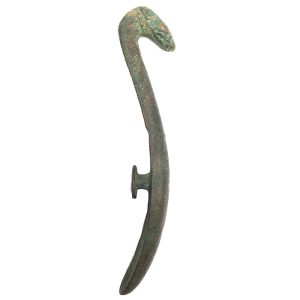
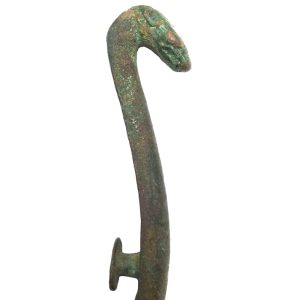
$485.00
H: 4.675” W: 1” D: 0.625” | FREE SHIPPING!
This Han bronze belt hook is fashioned as a dragon with intense eyes. A button-like extension on its underside affixes to a belt hole, and the hook is positioned horizontally to attach to clothing. Belt hooks were used in life and then buried with the diseased to accompany him on his journey to the afterlife. In very good condition, it has not been cleaned and has normal pitting and surface losses due to its two millennia-old burial in a humid tomb that has heavily oxidized over the years and, therefore, has beautiful verdigris deposits.
-
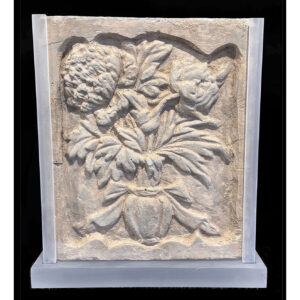
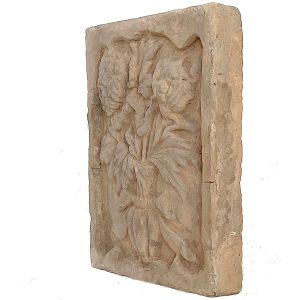
$995.00
H: 11” W: 9.5” D: 1.65” | FREE SHIPPING
This earthenware brick tile bordered with a deep scalloped frame depicts a vase with a bouquet of propitious flowers: a chrysanthemum and a peony wrapped with an elegant ribbon. Tiles like this were made to decorate the large numbers of buildings created during the prosperous Song dynasty and to adorn tombs. This elegant brick is in good condition for its age with expected chips and cracks, some restoration of background and a re-glued frame break on each side. It has earth adherents from its burial in a tomb.
-
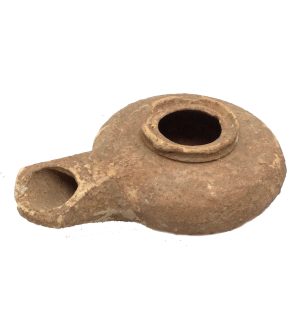
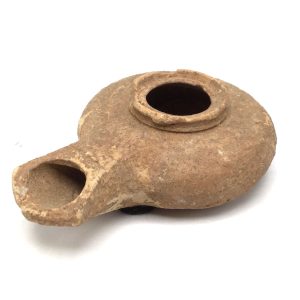
$155.00
SOLD
This Roman catacomb terracotta oil lamp is a basic, undecorated, and functional lamp beautiful in its simplicity. It is a well moulded piece with a finely rounded circular body, a short raised rim surrounding the fill hole centered in the middle, and has a hand made spatulate nozzle added to its body. The nozzle extends out with flat angular ridges and a wide opening to accommodate the wick which extends from inside the lamp,through the nozzle, and then reaches over its edge. It has no handle but, like all such lamps, it has a flat bottom to rest comfortably and securely on any surface. Much of the original crème slip on this lamp remains and has turned a brownish-beige from the soil in which it was buried underground. There are minor chips the rim atop the fuel chamber and projecting nozzle and is otherwise is very good condition.
-
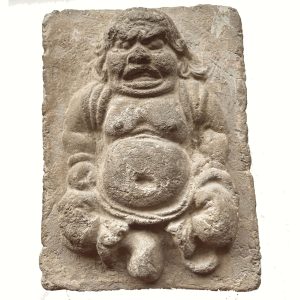
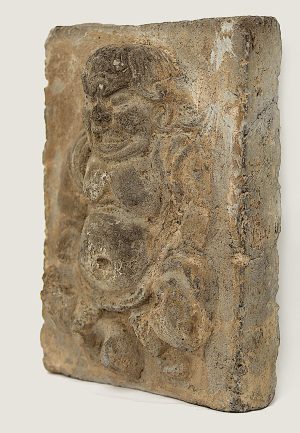
$475.00
H: 6.875” W: 5.25” D: 2.25 | FREE SHIPPING
This fascinating thick Song pottery brick is a low-fired depiction of a dwarf foreigner with a rotund belly, a large head and nose, an open mouth and abnormal features. The Chinese believed dwarfs could ward off evil spirits and sickness, attract peace and blessings (fu) and were very wise. Images of dwarfs became so popular, some were produced in numbers.
-
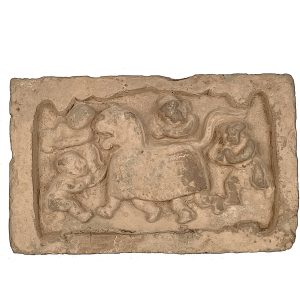
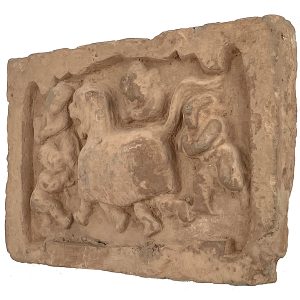
$495.00
H: 7.25” W: 11.5” D: 1.75” | FREE SHIPPING
This animated scene depicts the traditional Chinese Lion Dance performed at Chinese New Year, weddings, other important events and to honor guests, bring prosperity, happiness, good luck and ward off evil spirits. During the Song Dynasty tiles adorned the wall of tombs as well as government and important buildings with depictions of celebrations, mythology and deities and often included mythical animals, plants, vegetation and other auspicious objects.
-
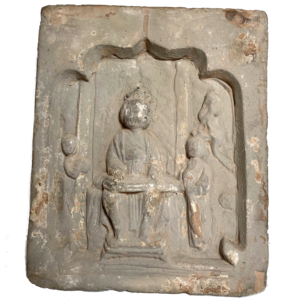
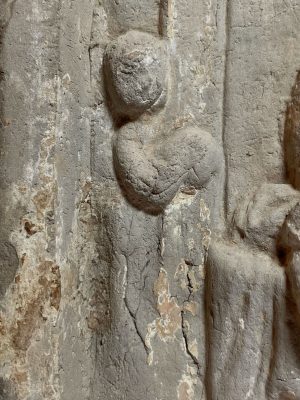
$475.00
H: 9” W: 9” D: 2.25” | FREE SHIPPING
This thick decorative Song brick tile portrays a seated female musician holding a lute in a hall with attendants on each side and third person in the distance framed in a decorative wide border with a pointed ogee arch. Since most ancient buildings with these pieces used un-reinforced fired construction, they were subject to disasters and few survived intact.
-
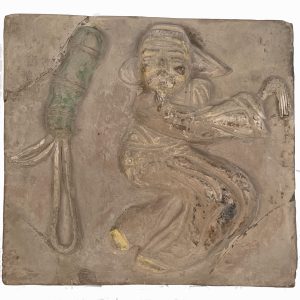
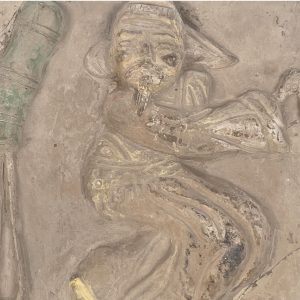
$495.00
H: 7” W: 5” D: 2.75” | FREE SHIPPING
This Song earthenware tile depicts the legendary scholar, poet and alchemist Taoist deity Lu Dongbin, one of the Eight Immortals, who sought to discover the elixir of immortality and used charms still used in Chinese homes to prevent illness and ward off evil. He and his fly whisk are auspicious symbols of longevity and a wish for immortality.
-
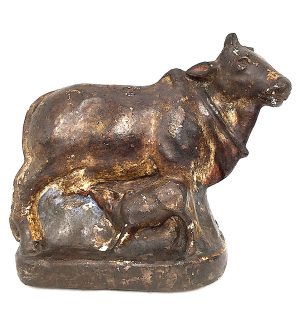
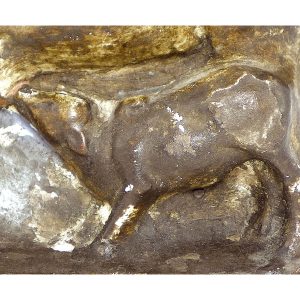
$105.00
H: 7” W: 8.25” D: 3.125” | FREE SHIPPING
This charming vintage figurine of a cow suckling its calf was mold-made in separate parts, hand-luted and painted, resulting in images made from the same mold unique and individualized. Pieces like this were created by provincial craftsman for use in home altars along with favored deities. Although having strong rural roots, terracottas have become an integral part of the life of Indians of all socio-economic levels and many of these images are displayed in most Indian households. As modern pieces are mass-produced, those produced in the first half of the 20th century are becoming viewed as collectibles.
-
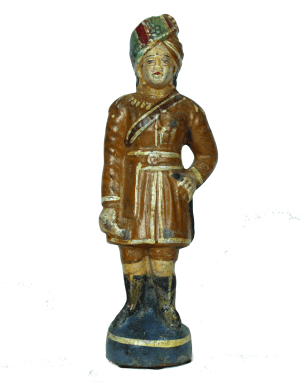
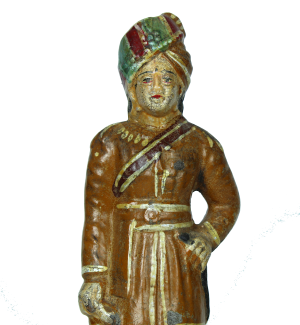
$105.00
H: 10.25 W: 3.5″ D: 2.75″ | FREE SHIPPING!
This colorful terracotta figurine of an Indian policeman stands on a blue base wearing a typical outfit of black boots, a long-sleeved tunic with white borders, a high belt, and a red, green, and brown wrapped turban with white borders that combine to portray an extremely confident figure. This vintage image is mold-made in two parts and was hand-luted and artfully hand-painted so all images made from the mold are unique and individualized. The provincial piece was created by a village craftsman and it is possible it may have been used in a home altar. It is in good condition with some minor surface cracks, paint losses and repainting to the nose.
-
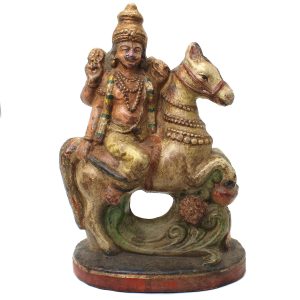
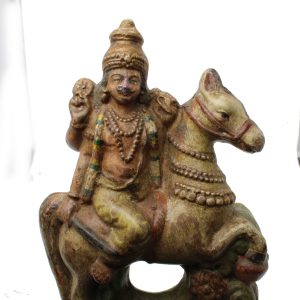
$145.00
H: 9.125″ W: 6.125″ D: 3.5″ |FREE SHIPPING
This charming colorful terracotta image represents a crowned mustached raja – an Indian King, prince, noble or dignitary – with an elaborate high crown and sumptuous jewelry draped over his chest riding an elegant and well-muscled rearing horse with its front right leg in the air, a common theme in Indian art. The decorative garlands around the horse’s neck, green plants, and ground over which the horse and rider glide, long arching horse tail, the twist of the raja’s body so he faces forward, and other aspects of the piece add dramatic energy. Made from bivalve moulds that are hand luted and painted, no two images are identical.
End of content
End of content



















